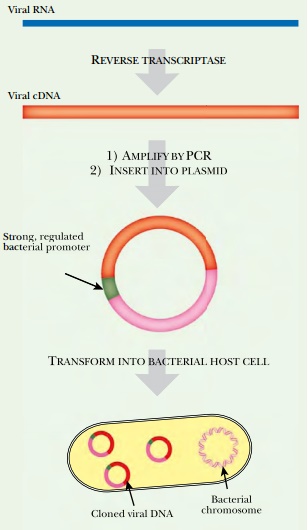Chapter: Biotechnology Applying the Genetic Revolution: Biowarfare and Bioterrorism
Creation of Camouflaged Viruses
CREATION OF CAMOUFLAGED VIRUSES
Another worrying achievement
of genetic engineering is the ability to hide a potentially dangerous virus
inside a harmless bacterium. This is not really novel, because bacteriophages naturally
insert their genomes into bacterial chromosomes or plasmids and later reemerge to
infect other hosts. Using standard molecular biology, it is possible to clone
the entire genome of a small virus that normally infects animals or plants and
then insert it into a bacterial plasmid, essentially hiding a pathogenic virus
inside harmless bacteria. To accommodate the genomes of larger viruses,
bacterial artificial chromosomes may be used instead of plasmids. In the case
of RNA viruses, a cDNA copy of the virus genome must first be generated by
reverse transcriptase before cloning it into a bacterial vector. There are
three main technical issues to face when cloning complete virus genomes:
(a) The fidelity of reverse transcriptase
and of the polymerase used during PCR. The enzymes that were originally
available introduced too many errors. Nowadays, high-fidelity reverse
transcriptase and PCR polymerases are available. Hence the length of RNA or DNA
that can be generated error-free has greatly increased.
(b) Suitable vectors to carry large inserts
of DNA. Vectors able to carry extremely large inserts, such as bacterial or
yeast artificial chromosomes (BACs and YACs), have been developed to clone and
sequence large segments of eukaryotic genomes.
(c) Certain base sequences found in virus
genomes are not stably maintained or replicated on plasmids in bacterial hosts.
These are referred to as poison sequences . For example, the cDNA version of
yellow fever virus could not be cloned in one piece. Instead it was cloned as
two segments that were replicated separately in a bacterial host. To generate a
complete, functional cDNA, the two fragments had to be ligated invitro .
This problem can sometimes be solved by using a suitable low-copy vector.
Many cell types, both
bacterial and eukaryotic, can take up DNA or RNA under certaincircumstances by
transformation. Consequently the naked nucleic acidgenomes of many viruses
(both DNA and RNA) are infectious even in the absence of theirprotein capsids.
Once a virus genome is cloned, DNA molecules containing the virus genomecan be
generated by replication of the plasmid inside the bacterial host cell.
Although suchDNA contains extra
plasmid sequences, it still may be infectious if transformed into
theappropriate host cell.
Amazingly, this is sometimes even true
for RNA viruses—that is, the cDNA version of an RNA virus can successfully
infect host cells and give rise to a new crop of RNA-containing virus
particles. For this to occur, the cDNA must enter the nucleus of the host cell
and be transcribed to give an RNA copy of the virus. The viral RNA then
proceeds through its normal replication cycle. This has been demonstrated for
RNA viruses such as poliovirus, influenza, and coronavirus (one of the
causative agents of common colds).


An improved strategy for generating RNA
viruses is to clone the cDNA version of their genomes onto a bacterial plasmid
downstream of a strong promoter ( Fig. 23.13 ). In this case, the natural RNA
version of the virus genome will be generated by transcription. This may be done
inside the bacterial host cell by using a bacterial promoter. Alternatively, a eukaryotic
promoter may be used to improve transcription of cDNA into viral RNA once the
cDNA has entered the eukaryotic host cell. The technology thus exists to create
bacteria carrying “hidden” plasmid-borne animal viruses. If the complete cDNA
from an RNA virus is placed under control of a strong bacterial promoter, the
bacterial cell could generate large amounts of infectious viral RNA internally
by transcription. When the bacterial cell dies and disintegrates, the viral RNA
would be liberated. If a dangerous human RNA virus was loaded into a harmless
intestinal bacterium under control of a promoter designed to respond to
conditions inside the intestine, this could pose a serious threat.
Related Topics